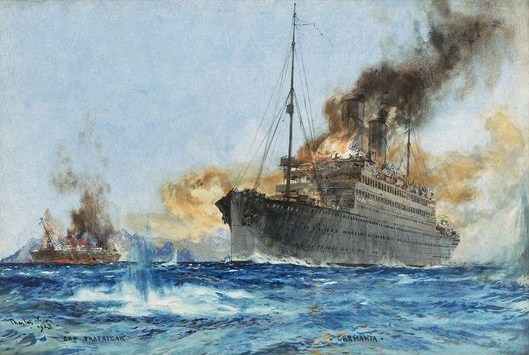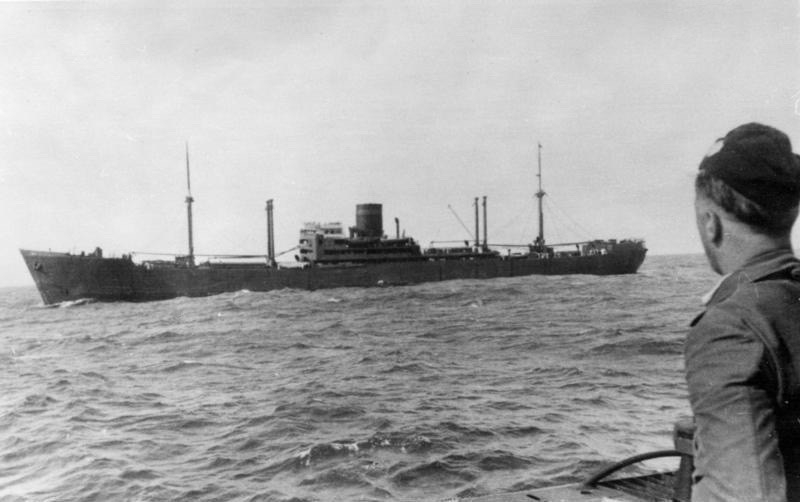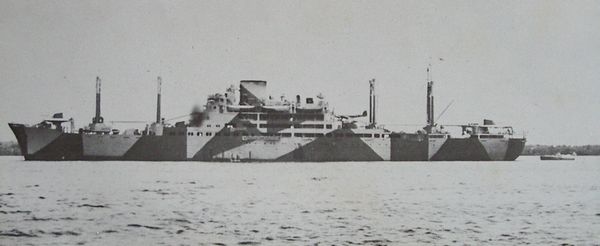List Of Auxiliary And Merchant Cruisers on:
[Wikipedia]
[Google]
[Amazon]
The following is a list, by period and country, of armed merchant ships used since the late 19th century in the role of auxiliary cruisers, also called armed merchant cruisers.


 At the outbreak of war, the ''Kriegsmarine'' requisitioned a number of fast merchantmen and immediately sent them into naval shipyards to be converted into offensive auxiliary cruisers. These ships had at the time of building been fitted with extra strong decks specifically to facilitate the installation of military equipment when required, but this was the only difference between them and other merchantmen of the period. No precise plans had been drawn up for the conversion of these ships into warships, and consequently the conversion process was painfully long. Compared to the diversity of British auxiliary cruisers, the ''Hilfskreuzer'' were standardized insofar as possible. The ships themselves averaged approximately . Armament usually consisted of six 6 in guns, two to six
At the outbreak of war, the ''Kriegsmarine'' requisitioned a number of fast merchantmen and immediately sent them into naval shipyards to be converted into offensive auxiliary cruisers. These ships had at the time of building been fitted with extra strong decks specifically to facilitate the installation of military equipment when required, but this was the only difference between them and other merchantmen of the period. No precise plans had been drawn up for the conversion of these ships into warships, and consequently the conversion process was painfully long. Compared to the diversity of British auxiliary cruisers, the ''Hilfskreuzer'' were standardized insofar as possible. The ships themselves averaged approximately . Armament usually consisted of six 6 in guns, two to six
 *
*''
*
*''
 The
The

Ships by period
Spanish–American War
American auxiliary cruisers
Russo-Japanese War
Japanese merchant cruisers
Russian merchant cruisers
Note: This listing is incomplete.World War I
Allied merchant cruisers
=Royal Navy
==Royal Australian Navy
==French Navy
=German auxiliary cruisers
Spanish Civil War
TheSpanish Nationalist
The creation of the tradition of the political community of Spaniards as common destiny over other communities has been argued to trace back to the Cortes of Cádiz. Revisiting the history of Spain, after 1812 Spanish liberalism tended to take fo ...
s, whose navy was substantially outnumbered by the Republicans, made an extensive use of auxiliary cruisers during the Spanish civil war
The Spanish Civil War ( es, Guerra Civil Española)) or The Revolution ( es, La Revolución, link=no) among Nationalists, the Fourth Carlist War ( es, Cuarta Guerra Carlista, link=no) among Carlists, and The Rebellion ( es, La Rebelión, lin ...
, two of them on loan from Italy
Italy ( it, Italia ), officially the Italian Republic, ) or the Republic of Italy, is a country in Southern Europe. It is located in the middle of the Mediterranean Sea, and its territory largely coincides with the homonymous geographical re ...
:
World War II
Allied merchant cruisers
The Armed merchant cruisers were made by requisitioning large ships and providing them with guns and other equipment. They ranged from . The armament varied but six guns with guns as secondary was usual. From 1941, many served as troopships.=
Royal Australian Navy
The Royal Australian Navy (RAN) is the principal naval force of the Australian Defence Force (ADF). The professional head of the RAN is Chief of Navy (CN) Vice Admiral Mark Hammond AM, RAN. CN is also jointly responsible to the Minister of ...
=
*
*
=
Royal New Zealand Navy
The Royal New Zealand Navy (RNZN; mi, Te Taua Moana o Aotearoa, , Sea Warriors of New Zealand) is the maritime arm of the New Zealand Defence Force. The fleet currently consists of nine ships. The Navy had its origins in the Naval Defence Act ...
=
*
=
Royal Canadian Navy
The Royal Canadian Navy (RCN; french: Marine royale canadienne, ''MRC'') is the Navy, naval force of Canada. The RCN is one of three environmental commands within the Canadian Armed Forces. As of 2021, the RCN operates 12 frigates, four attack s ...
=
*
*
*
=
Royal Navy
The Royal Navy (RN) is the United Kingdom's naval warfare force. Although warships were used by English and Scottish kings from the early medieval period, the first major maritime engagements were fought in the Hundred Years' War against F ...
=
=
French Navy
The French Navy (french: Marine nationale, lit=National Navy), informally , is the maritime arm of the French Armed Forces and one of the five military service branches of France. It is among the largest and most powerful naval forces in t ...
(''Marine Nationale'')=
French auxiliary cruisers were armed with 138 mm, 152 mm or 150 mm guns, 75 mm and 37 mm AA guns and 13.2 mm or 8 mm AA HMG
* (X01)
* (X03)
* (X03)
* (X05)
* (X06)
* (X07) (lost on 6 May 1942)
* (X10)
* (X11)
* (X13)
* (X16)
* (X17)
* (X18)
* (X19)
* (X20)
* (X21)
* (X22) (hit a mine and sunk on 19 June 1940)
German auxiliary cruiser raiders

 At the outbreak of war, the ''Kriegsmarine'' requisitioned a number of fast merchantmen and immediately sent them into naval shipyards to be converted into offensive auxiliary cruisers. These ships had at the time of building been fitted with extra strong decks specifically to facilitate the installation of military equipment when required, but this was the only difference between them and other merchantmen of the period. No precise plans had been drawn up for the conversion of these ships into warships, and consequently the conversion process was painfully long. Compared to the diversity of British auxiliary cruisers, the ''Hilfskreuzer'' were standardized insofar as possible. The ships themselves averaged approximately . Armament usually consisted of six 6 in guns, two to six
At the outbreak of war, the ''Kriegsmarine'' requisitioned a number of fast merchantmen and immediately sent them into naval shipyards to be converted into offensive auxiliary cruisers. These ships had at the time of building been fitted with extra strong decks specifically to facilitate the installation of military equipment when required, but this was the only difference between them and other merchantmen of the period. No precise plans had been drawn up for the conversion of these ships into warships, and consequently the conversion process was painfully long. Compared to the diversity of British auxiliary cruisers, the ''Hilfskreuzer'' were standardized insofar as possible. The ships themselves averaged approximately . Armament usually consisted of six 6 in guns, two to six torpedo tube
A torpedo tube is a cylindrical device for launching torpedoes.
There are two main types of torpedo tube: underwater tubes fitted to submarines and some surface ships, and deck-mounted units (also referred to as torpedo launchers) installed aboa ...
s, and an assortment of , 37 mm, and automatic weapons. Most of these merchant raider
Merchant raiders are armed commerce raiding ships that disguise themselves as non-combatant merchant vessels.
History
Germany used several merchant raiders early in World War I (1914–1918), and again early in World War II (1939–1945). The cap ...
s carried an Arado Ar 196
The Arado Ar 196 was a shipboard reconnaissance low-wing monoplane aircraft built by the German firm of Arado starting in 1936. The next year it was selected as the winner of a design contest and became the standard aircraft of the ''Kriegsmarin ...
floatplane
A floatplane is a type of seaplane with one or more slender floats mounted under the fuselage to provide buoyancy. By contrast, a flying boat uses its fuselage for buoyancy. Either type of seaplane may also have landing gear suitable for land, ...
for reconnaissance. , , and were also equipped with small motor torpedo boat
A torpedo boat is a relatively small and fast naval ship designed to carry torpedoes into battle. The first designs were steam-powered craft dedicated to ramming enemy ships with explosive spar torpedoes. Later evolutions launched variants of se ...
s. In addition to armament, increased fuel, water, and coal storage had to be provided for as well. Furthermore, the raiders could not abandon the crews of their captures, so space had to be provided for prisoners. The first ''Hilfskreuzer'' got under way in March 1940, shortly before the Norwegian campaign.
* (HSK-1)
* (HSK-2)
* (HSK-3)
* (HSK-4)
* (HSK-5)
* (HSK-6)
* (HSK-7)
* (HSK-8)
* (HSK-9)
* ''Coronel'' (HSK-10)
* (HSK-11)
Japanese armed merchant cruisers
Japan converted fourteen merchant ships to "armed merchant cruisers" but, by the end of 1943, five had been sunk and seven had been converted back to merchant ships. *
*''
*
*''Akagi Maru
''Akagi Maru'' was one of three of the Imperial Japanese Navy, and was launched in 1936. ''Akagi Maru'' was used initially used as a refrigerated cargo/passenger ship between ports in Japan, Europe and South America. The ship took part in World ...
''
* ''Asaka Maru''
* ''Awata Maru''
* ''Bangkok Maru''
*'' Gokoku Maru''
*''Hōkoku Maru
was an that served as an armed merchant cruiser in the Second World War. She was launched in 1939 and completed in 1940 for Osaka Shosen Lines.
In 1941 she was commissioned into the Imperial Japanese Navy. She served as a commerce raider and ...
''
* ''Kinryu Maru''
* ''Kiyozumi Maru''
*
* ''Noshiro Maru''
* ''Saigon Maru''
* ''Ukishima Maru''
Italian armed merchant cruisers
Unlike the Germans and the Japanese, none of the armed merchant cruisers (or auxiliary cruisers) of the Italian Royal Navy (''Regia Marina
The ''Regia Marina'' (; ) was the navy of the Kingdom of Italy (''Regno d'Italia'') from 1861 to 1946. In 1946, with the Italian constitutional referendum, 1946, birth of the Italian Republic (''Repubblica Italiana''), the ''Regia Marina'' ch ...
'') were deployed to destroy or capture Allied merchant ships and were mostly used as supply ships or escorts. All of them mounted two guns.
* - Lost on 27 February 1941 in battle
In Battle is an extreme metal band from Sundsvall, Sweden. The main lyrical themes of the band focus on Norse mythology and war.
History
The original line-up consisted of John Frölén on guitar and bass, John Odhinn Sandin on vocals, Håkan Sj� ...
with cruiser in the Indian Ocean
The Indian Ocean is the third-largest of the world's five oceanic divisions, covering or ~19.8% of the water on Earth's surface. It is bounded by Asia to the north, Africa to the west and Australia to the east. To the south it is bounded by th ...
while fleeing Italian East Africa
Italian East Africa ( it, Africa Orientale Italiana, AOI) was an Italian colony in the Horn of Africa. It was formed in 1936 through the merger of Italian Somalia, Italian Eritrea, and the newly occupied Ethiopian Empire, conquered in the Seco ...
for Japan
Japan ( ja, 日本, or , and formally , ''Nihonkoku'') is an island country in East Asia. It is situated in the northwest Pacific Ocean, and is bordered on the west by the Sea of Japan, while extending from the Sea of Okhotsk in the north ...
as an armed transport.
* - Never active as an Italian armed merchant cruiser and, after being chartered by the Japanese as the ''Calitea II'', lost on 12 January 1945
* - Converted into an escort vessel and never served as an armed merchant cruiser, she took part of the battle of Otranto
The Ottoman invasion of Otranto occurred between 1480 and 1481 at the Italian city of Otranto in Apulia, southern Italy. Forces of the Ottoman Empire invaded and laid siege to the city, they captured it on 11 August 1480 establishing the firs ...
* - Converted into a hospital ship
A hospital ship is a ship designated for primary function as a floating medical treatment facility or hospital. Most are operated by the military forces (mostly navies) of various countries, as they are intended to be used in or near war zones. ...
and never served as an armed merchant cruiser
Romanian armed merchant cruisers
 The
The Romanian Navy
The Romanian Navy ( ro, Forțele Navale Române) is the navy branch of the Romanian Armed Forces; it operates in the Black Sea and on the Danube. It traces its history back to 1860.
History
The Romanian Navy was founded in 1860 as a river flot ...
had one auxiliary cruiser, ''Dacia''. She was built in France in 1907 as a passenger ship. She was 109 meters long, her beam was 13 meters and her draught was 8 meters, and displaced 4,105 tons. Her top speed was . Initially she was an auxiliary minelayer, armed only with two 20 mm anti-aircraft guns and able to carry up to 200 mines. In 1942 she was also armed with three 105 mm naval/AA guns and designated as auxiliary cruiser (''crucişător auxiliar'').
References
Notes
Bibliography
* * {{DEFAULTSORT:List of auxiliary and merchant cruisers Auxiliary and merchant cruisers Auxiliary cruisers